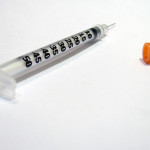 Insulin resistance is the tendency of your body’s cells to ignore the signals that the blood sugar regulating hormone insulin tries to send to them about taking up sugar (glucose) from your bloodstream. Insulin resistance is the hallmark of diabetes and pre diabetes and is responsible for many, though not all, of the core problems that type 2 diabetics face. Of course you know that weight loss and exercise are good ways to reduce insulin resistance and normalize your blood sugar levels.
Insulin resistance is the tendency of your body’s cells to ignore the signals that the blood sugar regulating hormone insulin tries to send to them about taking up sugar (glucose) from your bloodstream. Insulin resistance is the hallmark of diabetes and pre diabetes and is responsible for many, though not all, of the core problems that type 2 diabetics face. Of course you know that weight loss and exercise are good ways to reduce insulin resistance and normalize your blood sugar levels.
But, in some cases, weight loss is difficult, or does not work enough to get you back in good control of your blood sugar levels. One way to get your insulin resistance down is to make better food choices that lower the level of background inflammation that you cause in your body with certain foods. Low carb diet plans can really help you with that goal. These include foods you would admit to being addicted to eating, like certain sweets (sugar, wheat, milk/cream) or even wheat-containing/gluten-containing breads.
Or try to go for a Mediterreanean diet with antiinflammatory properties, high in fresh vegetables and low glycemic index fruits (like berries); use olive oil as your main fat; eat lots of fish (like wild salmon, sardines, tuna). Check out the gluten-free diet options you have — they are growing and quality and number for people who notice that their blood sugar levels are harder to control in the 4-24 hours after they eat a food to which they are intolerant, like wheat-containing bread. You can find brown rice breads and other forms to replace wheat for a couple of weeks. Follow your blood sugar levels and see if the new diet makes it easier to get on top of your diabetes. It isn’t always wheat or carbs – it can even be a commonly eaten food like beef. You need to keep a food and blood sugar diary to know for sure.
Also, here are 3 ways to lower your blood sugar by reducing your insulin resistance that you can add to your overall self care plan:
1. Alpha lipoic acid – this versatile antioxidant seems to be particularly helpful for people with diabetes. It can reduce the pain and discomfort from diabetic neuropathy, which recent research suggests may not always be due to the high blood sugar levels. If this is the case, then loss of nutrients may be playing a role. Alpha lipoic acid can recycle the good forms of vitamin C and vitamin E and even stand in for them if they are deficient. It may protect liver and nerve cells in the brain from a variety of other problems, including hypoglycemic episodes (low blood sugars) that can occur from accidental overtreatment with insulin. For reducing insulin resistance, alpha lipoic acid can get your blood sugar levels lower in addition to its protective effects for nerve cells. Look for the R-stabilized form of lipoic acid for best effects.
2. Cinnamon – this tasty spice does have blood sugar lowering capabilities. Sprinkle it on food like whole grain oatmeal when you eat the oatmeal. It may help you process the carbs in the oatmeal better and will add a great taste besides.
3. Chromium picolinate – this trace mineral appears to be helpful in reducing insulin resistance for type 2 diabetics (probably not as helpful for type 1 diabetics).
Always talk with your doctor and make sure to monitor your blood sugar levels. Diabetes is not a spectator sport, unfortunately. You have to get involved to get the best results.
